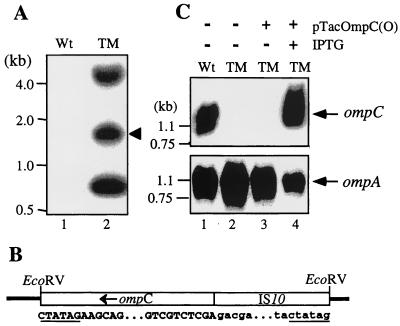FIG. 1.
Analysis of an E. coli O157:H7 mutant (TM) created by Tn10 transposition. (A) Southern blot analysis of bacterial chromosomal DNAs that had been digested with EcoRV and hybridized with an IS10 probe. (B) Schematic diagram of the sequenced IS10-containing fragment in TM. The EcoRV fragment of TM (indicated by an arrowhead in panel A) was inserted into EcoRV-cut pBluescript II SK(+) and sequenced. The junctions between the insert (open box) and the vector (thick line) are illustrated, and portions of the cloned sequence are shown beneath. The EcoRV restriction sites are underlined. The sequence in the middle portion illustrates where ompC (capital letters) was disrupted by the IS10 insertion (lowercase letters). (C) Northern blot analysis of RNAs isolated from the TM mutant. Total bacterial RNAs were extracted from different preparations of bacteria. The RNA (10 μg) was electrophoretically separated on an agarose gel, transferred to a nylon membrane, and hybridized with ompC (upper panel) and ompA (lower panel) probes, respectively. In this and the following experiments (Fig. 2), gene expression from the plasmids was induced with IPTG (1 mM). Wt, wild-type strain.

